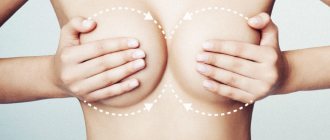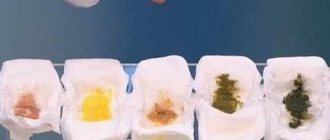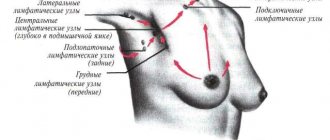Having discovered a lump in the mammary gland during breastfeeding, many women begin to panic. This is understandable, because in the first days and weeks of feeding the baby, the lactation process has not yet normalized, and the milk ducts can easily become clogged and inflamed. You can cope with the problem yourself if the lumps in the chest do not cause severe discomfort and there are no signs of mastitis developing. In order not to aggravate the situation and get rid of the seals, a nursing mother needs to be treated correctly; what exactly can be done will be discussed today.
Why do breasts get hard?
Mastopathy is a common disease among women of any age. Elimination of this pathology takes up 50% of the practice of mammologists. Breast thickening is manifested by:
- Sebaceous gland cyst. Occurs due to blockage of the milk ducts. Significantly increases in volume after damage or increased hormonal levels. A painless, non-disturbing condition requires no treatment without aggravating consequences. In complicated cases, surgical intervention is performed: the tumor sac is removed through a minor incision in the skin. The surgical method completely eliminates the recurrence of the pathology.
- Breast cyst. Does not provoke the development of cancer, similar to the previous one (except for localization). Hard sacs with fluid can be found anywhere in the chest and are characterized by mobility under the physical influence of the fingers. Women under 50 years of age are susceptible to the disease due to high levels of hormones during the menstrual cycle. Pathology is rarely characterized by the appearance of pain. The prescribed therapy involves drainage of the cyst followed by aspiration of the contents.
- Breast lipoma. Round compaction of different sizes and locations. Sometimes several non-cancerous tumors are detected simultaneously in women with a large amount of adipose tissue.
Palpable balls in the mammary glands of girls under 16 years of age are one of the symptoms of mastopathy. Benign neoplasms occur before the onset of menstruation. The volume and arrangement of elements vary. Sometimes the presence of nodes is complemented by the appearance of dark, bloody mucous discharge from the nipples. The clinical picture indicates a high risk of tumor transformation into a malignant form.
Methods of treating pathologies
Doctors assure that milk stagnation can be dealt with within a few days, the main thing is not to start the disease and start treatment on time.
Important! Self-treatment with folk remedies without consulting a doctor can harm the health of the mother and baby.
About the importance of breastfeeding in the formation of stagnation of milk in the ducts
Lactation consultants, pediatricians and gynecologists agree that if milk stagnation occurs in the ducts, it is imperative to continue breastfeeding. A baby is a mother’s best assistant in the fight against this unpleasant disease. The fact is that during feeding the baby intensively sucks the breast, thereby helping to free the duct. An exception is the development of purulent mastitis. In this case, the doctor may prohibit breastfeeding for the duration of treatment.
Recommendations for breastfeeding when milk stagnation in the ducts:
- put the baby to the breast as often as possible (every 2 hours);
- choose a position in which the baby’s chin will be directed towards the place where the duct is blocked. It is in this position that the baby will empty the desired lobe of the mammary gland;
- express after feeding. It is better to do this manually in order to specifically target the area of stagnation. While pumping, you can easily massage the lump with your other hand. Experts recommend pumping no more than 2 times a day;
- Before feeding, it is recommended to take a warm shower to improve blood circulation and dilate the milk ducts. This will facilitate easier removal of milk from the breast.
Video: how to deal with lumps during breastfeeding
We trust the experience of generations: folk remedies
Women faced stagnation of milk decades ago. They were treated with folk remedies, among which cold compresses were considered the most popular and effective. Some recipes have survived to this day:
- Wash the cabbage leaf well and cool for 2 hours in the refrigerator. Then take out the sheet and beat it with a kitchen hammer. Apply a cabbage leaf to the area of the seal and secure with gauze or bandage. Leave the compress for 4 hours; if you do it at night, you don’t have to change it until the morning.
- Mix cold cottage cheese with honey and apply the resulting mass to the mammary gland, securing the top with a gauze bandage. After 3 hours you need to change the compress.
- Add cold milk and a little melted butter to the rye flour. Mix everything thoroughly, form a cake and apply to the place of stagnation. Change the cake after it warms up. Some women say that this compress is great for relieving pain.
- A regular piece of gauze or a piece of any fabric soaked in cold water quickly relieves pain. This compress needs to be changed as the tissue heats up.
Modern methods: drugs
Very often, doctors prescribe medications to treat lumps in the mammary glands. Most mothers are afraid of harming the baby’s health, so they are afraid to be treated with medications. However, the doctor always selects a drug that is either combined with breastfeeding or has minimal risks.
It is worth noting that for the treatment of cysts or mastopathy, medications are selected strictly individually and depending on the stage of the disease. The fact is that in some cases hormonal drugs are effective, while in others only surgical intervention can help.
Interesting: to decipher breasts with lumps, a special procedure is used - ultrasound. Ultrasound for lactostasis helps to improve the outflow of milk, and also normalizes blood circulation by increasing the temperature in the mammary glands.
Vskormi.ru
https://vskormi.ru/breast-problems/ultrazvuk-pri-laktostaze/
But seals that arise as a result of blockage of the milk ducts can be effectively treated with ointments or tablets. Many medications are used to relieve symptoms of the disease. For example, to combat fever during mastitis, drugs based on paracetamol (Panadol, Efferalgan) or ibuprofen (Nurofen) are used in children's forms.
Table: medications that are used to treat lumps in the mammary glands
| Name | Release form | Indications for use | Properties and efficiency | Contraindications | Side effects | Approximate price (in rubles) |
| Progestogel 1% | Gel | The hormonal agent is prescribed as part of a complex treatment for mastodynia (unpleasant sensations in the breast area with increased sensitivity when touched) and cystic mastopathy |
|
|
| 900 |
| Traumeel S | Prescribed as part of complex treatment for lactostasis and mastitis |
|
| Occurs rarely and manifests itself in the form of allergic reactions | 400 | |
| Malavit | Ointment |
| 270 | |||
| Arnica | Homeopathic medicine to relieve symptoms of lactostasis |
| 55 | |||
| Levomekol | Antibiotic ointment is prescribed to quickly heal the wound and prevent infection after surgery for mastitis. |
|
|
| 90 | |
| Amoxiclav | Pills | Broad-spectrum antibiotic to fight infection in purulent mastitis | Effectively fights against many bacterial strains that multiply in the ducts during lactostasis and mastitis | Allergic reactions | When treated during lactation, the baby may develop:
| 105 |
| Augmentin | 110 | |||||
| Dostinex | A drug to stop lactation. Prescribed for stagnation of milk due to hyperlactation caused by high levels of prolactin in the blood | The hormonal drug affects the reduction of prolactin production |
| Many side effects from different organs and systems | 540 | |
| Oxytocin | Solution for injection in ampoules | To increase oxytocin levels in women with slow milk flow through the ducts due to hormonal imbalance |
| Allowed during breastfeeding only after a doctor's prescription |
| 30 |
Photo gallery: drugs prescribed for the treatment of lactostasis and mastitis
The gel will help with the complex treatment of mastodynia and cystic mastopathy

Homeopathic gel Traumeel C is often prescribed for the treatment of lactostasis
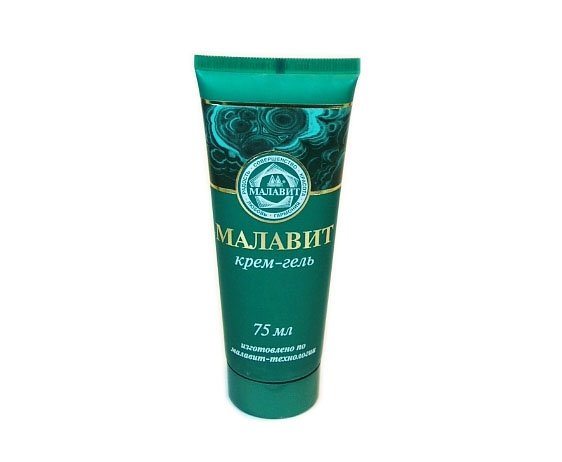
Malavit ointment will help quickly relieve swelling
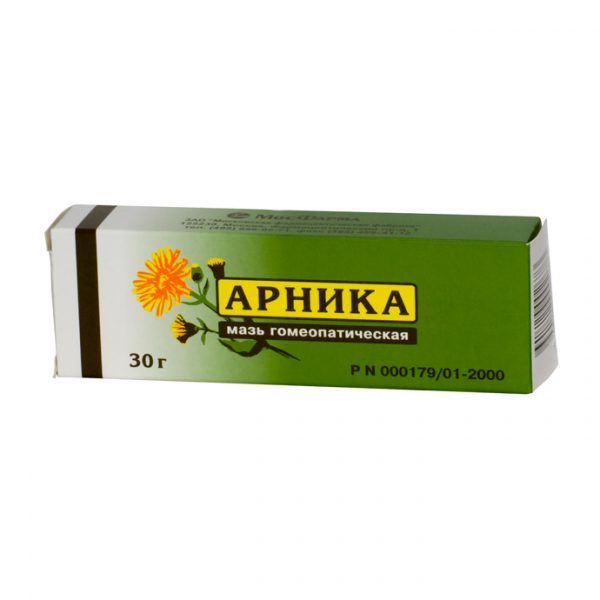
Arnica ointment contains extracts of medicinal herbs

Levomekol ointment effectively fights bacteria and promotes rapid wound healing
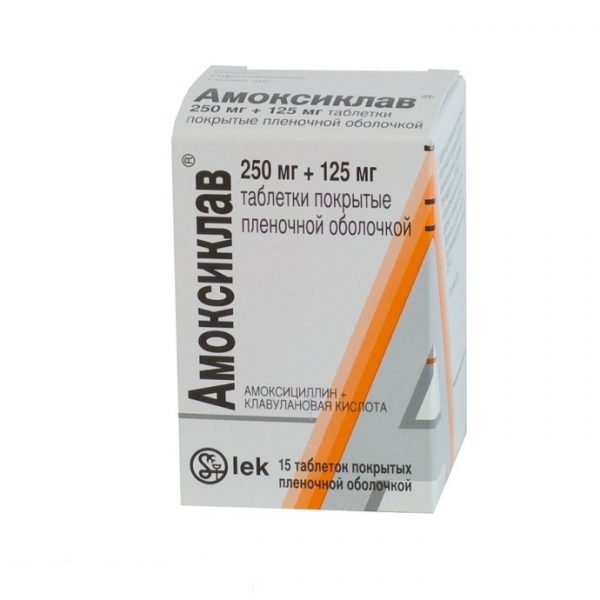
Amoxiclav - an antibacterial drug helps in the treatment of purulent mastitis
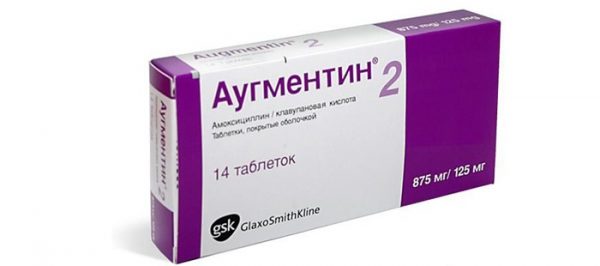
Augmentin is an antibiotic that can be prescribed during breastfeeding
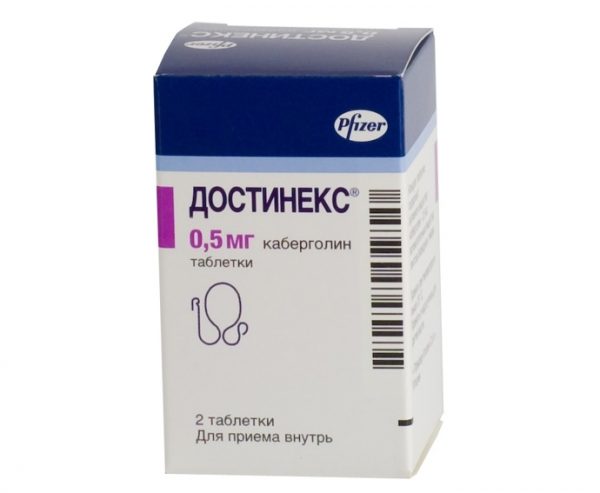
Dostinex is a hormonal drug prescribed to stop or reduce lactation.
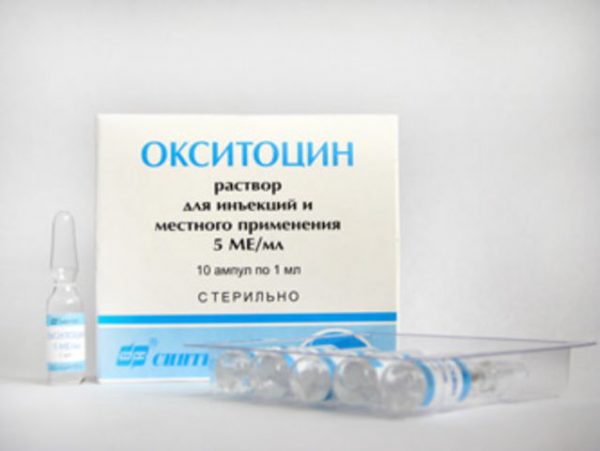
Oxytocin is prescribed in complex therapy for lactostasis and mastitis

Nurofen has an antipyretic and analgesic effect, and will also help relieve inflammation
From the experience of lactating women: reviews of drug treatment of diseases
With the birth of my baby, I encountered such a disaster and problem as lactostasis. Lactostasis is the stagnation of milk in the ducts of the mammary glands. If a milk segment is not freed from milk for a long time or the duct is pinched, then a milk plug is formed. When feeding and pumping, the breast hurts and when you touch it too, the skin over the clogged duct turns red, the temperature rises, there may be several lumps (I had all the symptoms and the temperature was 38.5), if lactostasis is not immediately treated, then after 3– Within 4 days it can turn into uninfected mastitis, which means that only surgery will help. I used compresses with honey and cabbage leaves, massage, everything in combination, it became easier, then I added Traumeel S ointment, and after 2 days the pain subsided, the redness went away and it became easy to feed. Girls, do not delay the treatment of lactostasis, Traumeel ointment will help you.
Uzdenovael
https://otzovik.com/review_4608570.html
Levomekol ointment helps very well, I recommend it.
Ecliptic
https://www.babyplan.ru/questions/63849-laktostaz-opyt-byvalyh/
My first lactostasis lasted 4 days, it cleared up and was confirmed by ultrasound. Second, the temperature lasted half a day, my chest hurt for a day. The gynecologist felt my breasts and confirmed my suspicions - a small lump. Now, after the first injection of Oxytocin, the breasts are much softer, the compaction has become less. Tomorrow is the second injection, we'll see. I hope it doesn't cause mastitis.
Alka1
https://www.babyplan.ru/questions/113535-oksitotsin-pri-gv/
I became acquainted with the antibiotic Amoxiclav during breastfeeding. In the first month of my motherhood, I experienced stagnation of milk in my breasts. This very unpleasant situation requires a quick solution, because the consequences of stagnation can be serious. During stagnation, the temperature rises sharply, but it must be measured in the elbow or knee bend. When measuring the temperature in the classic way (armpits and under the tongue), the thermometer will show it higher - all this is due to milk stagnating in the mammary glands. My chest starts to hurt. The condition is terrible. Many women experience milk stagnation. So I couldn’t avoid this unpleasant moment. Not knowing what to do or what measures to take, we got ready and went to the maternity hospital where I gave birth. They examined me and said there was nothing wrong. They recommended taking Amoxiclav and making lotions, they said it would help quickly. The doctor spoke about 2-3 days of admission as needed. And I was consoled by the words: “In the morning it will be much easier.” Upon arrival home, I took the antibiotic Amoxiclav, we bought children's Linex for the child, still, do not forget that antibiotics not only kill bad microbes, but also good ones. In the morning it really felt better, the temperature subsided, and my chest stopped swelling. There was an opportunity to settle down. I got by with one dose (one tablet). So I am grateful to Amoxiclav. Helped me.
Zhuzhik89
https://otzovik.com/review_3065358.html
Traumeel S really helps. It will relieve pain, help milk flow, and will not harm the baby. Only you don’t just need to spread it on, but do a gentle massage, wait until the cream is absorbed and then decant. And let my husband help me, after the maternity hospital my husband helped me, I struggled for three days, it hurt, it took a long time, but then it was easier.
Polina Stupina
https://deti.mail.ru/forum/nashi_deti/kormim_grudju/laktostaz_pomogite/?page=3
Hard breasts during pregnancy
Swelling and increased sensitivity of the breast are natural phenomena that accompany the period of gestation. Symptoms are caused by hormonal changes in the body. If the mammary glands harden during pregnancy, this is an unfavorable sign, in 50% of cases indicating its fading. The only correct tactic is to immediately contact a gynecologist. It is possible that curettage of the uterine cavity will be required.
When planning the volume and nature of the intervention, the gynecologist is guided by the patient’s complaints, the results of the examination and ultrasound of the uterus.
Only in 1 case out of 50 does a woman find out about her pregnancy when the mammary glands harden.
Hard breasts after feeding
The appearance of lumps inside the mammary glands is often found among women during breastfeeding. Irregular or incomplete expression of milk contributes to blockage of the canals. Simultaneous pain, increased temperature, redness, and swelling indicate inflammatory processes. Sometimes the listed clinical manifestations indicate the initial stage of mastitis. To prevent negative consequences, you must adhere to the basic rules of lactation:
- Systematically breastfeed your baby without interruptions. If the child refuses to feed, express milk.
- Do not squeeze the mammary glands with clothing, so as not to interfere with the passage of milk through the channels. The release of milk outside of feeding is considered normal, but only in the first stages of lactation, while the body gets used to the regime.
- Choosing the right breastfeeding position. There are a lot of educational materials that can help a new mother.
It is important to follow the doctor’s recommendations so as not to suffer inconvenience and switch to artificial nutrition. A balanced regimen helps to resolve breast hardness and relieve pain in a short time.
What to do if there is a lump in the mammary gland
Hardening in the mammary gland in a nursing woman in a mild form can be eliminated if measures are taken immediately.
Warming up the breast
Lumps in the mammary gland during lactation can be removed with heat. To do this, use warm water for a few minutes or use magnesia . Buy an ampoule at a pharmacy, moisten gauze with the medicine and apply it to the lump. Secure with a bandage or wear an elastic top. Wear something warm on top to enhance the effect.
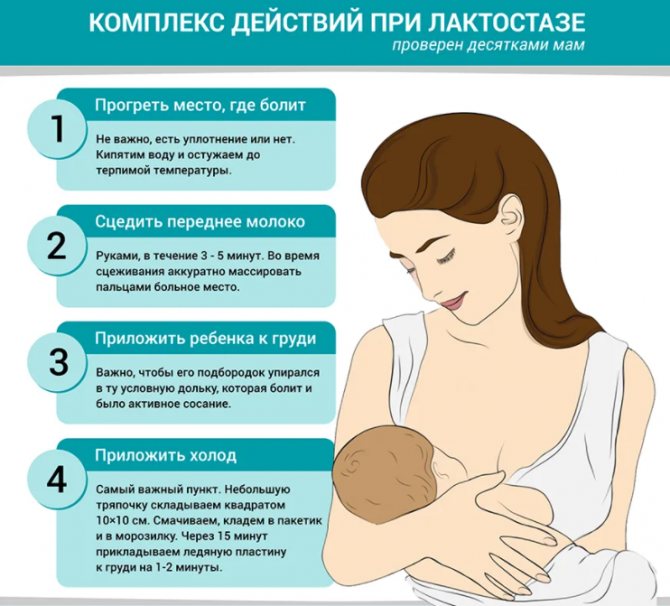
Massage

You need to start massaging your breasts from the armpit, directing your finger movements towards the nipple. Since lumps often occur from below, more attention should be paid to the lower part of the breast. Do not press too hard so as not to injure the lobule in which the blockage occurred. If a woman has a high temperature, it is better to immediately consult a doctor so that he can determine whether mastitis has begun.
If painful areas remain after feeding, they are additionally massaged. It is important that problem areas are eliminated immediately, otherwise prolonged stagnation can provoke serious inflammation.

Valeria
General doctor
Ask a Question
If congestion is a frequent concern, you should make it a rule to start each feeding with a massage. This will release milk. It is collected in a bottle and stored or expressed on a towel.
Compress
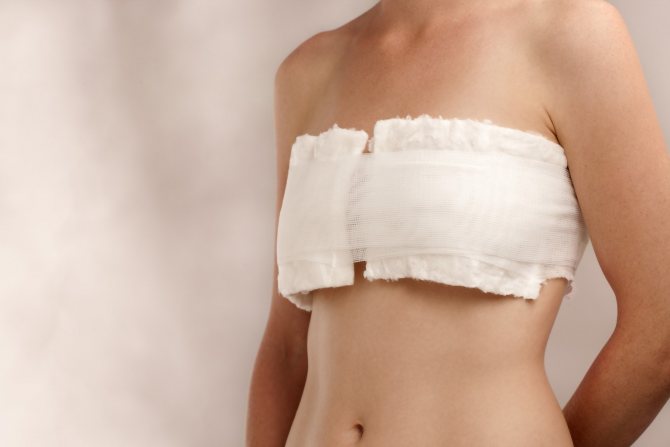
Natural ointments with a bactericidal effect will help relieve inflammation and prevent infection: these are ichthyol and Vishnevsky ointment . Ichthyol relieves pain and inflammation; it is applied to the chest or certain areas, then covered with a paper napkin.
Compresses based on camphor laurel oil have bactericidal, anti-inflammatory and analgesic properties. You can use one of the suggested recipes :
- two parts baby cream and one part camphor oil;
- butter, camphor and honey in equal parts;
- a tablespoon of camphor and melted propolis.
Apply any of these mixtures to a cabbage leaf or cloth, apply to the chest and wrap. contraindications for camphor oil - epilepsy, allergies, skin damage and heart disease.
Sea buckthorn, chamomile or arnica oil can be used as compresses . They are used to massage the breasts. This relieves swelling, relieves pain and relaxes muscles.
Folk remedies allowed for breastfeeding

You can put cabbage leaves in your bra
Folk remedies can help with the initial stage of mastitis, lactostasis, and mastopathy . Benign tumors do not respond well to conservative treatment methods. Moreover, you should not waste time and try to treat oncology with herbal preparations - this can end tragically.
Recipes for mastopathy, mastitis and lactostasis:
- Apply a cabbage leaf , slightly beaten with a rolling pin.
- Brew dill seeds and take small portions several times a day.
- Lubricating the mammary gland with honey improves milk flow.
- Eat more plant foods , since animal meat contains synthetic growth hormones.
If the situation does not improve when using natural remedies, you must stop self-medication and consult a doctor for qualified help.
Pumping
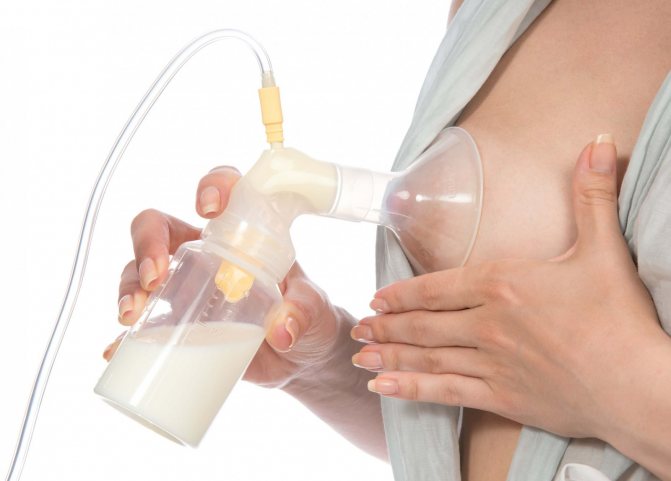
Convenient to use an electric breast pump
A breast lump in a nursing woman may appear due to irregular pumping of one breast, which the baby does not latch on well. Or there is a lot of milk and the baby has enough quantity in one mammary gland.
Pumping is done to increase milk production or to clear excess milk from the ducts. In the first case, the breast is expressed after feeding, in the second - before feeding. If the baby sucks only one breast, the second one must be fully or partially expressed. Milk can be stored in the freezer and reheated in warm water (not in the microwave) as needed.
Question to the expert
Is it possible to continue breastfeeding if there is a lump in the breast?
If you have painful lumps, you should not give up breastfeeding. No one will empty the mammary gland as effectively as the baby himself, so it is necessary to continue to apply it regularly, while simultaneously doing massage, compresses and pumping.
Firm breasts after mammoplasty
Increased density and hardening of the breast in plastic surgery is called capsular contracture. The condition is not caused by excessive rigidity or other characteristics of the implanted material, but by the body's reaction. In certain cases, the prosthesis is regarded by the immune system as a foreign body.
The density of the gel contents gives an idea of what the breasts will feel like after surgery. A kind of protective shell is formed in the mammary glands, consisting of connective tissue and inflamed structures. They are like a capsule or a hard ball that envelops the location of the surgical intervention.
On average, it will take at least 2 months of recovery period with supportive drug therapy. Additionally, the patient should refrain from physical activity in order to:
- stop swelling;
- annihilate pain;
- restore sensitivity;
- normalize well-being.
The denser the capsules are formed, the firmer the breast becomes. The time frame for normalization of the condition of the mammary glands is individual for each individual case and the surgical intervention performed. The return of the necessary softness to the breast occurs after complete rehabilitation.
Due to the implantation of breast implants, abscess diagnosis is much less common. The condition is characterized by pain in the area of infection and is observed in any part of the breast. Inflammatory symptoms are pronounced: redness, hardening of the surface, the skin becomes hot to the touch. Treatment includes placement of drainage and a course of antibiotics.
Hard breasts after childbirth
Fat necrosis is a dangerous breast disease in which healthy breast cells mutate into round, hard tumors. The diagnosis is confirmed by a change in skin color around the tumor: the surface of the epidermis turns blue or red. There may be no pain.
The pathology is provoked by hormonal imbalance and subsequent sudden weight gain after childbirth, as well as mechanical and other damage to the breast. The consequences of the injury can appear even after several years, including the formation of scar tissue. During this period, the vital activity of fat cells undergoes significant changes that do not require special treatment.
Folk remedies for relieving lactostasis
Women use folk remedies to alleviate physical conditions. Among the popular options, there are a couple of types of compresses that bring relief.
- Compress made from natural honey. Wheat flour and honey are used. The ingredients are mixed until a dense dough is formed. A cake is formed and applied to the site of formation. The top is covered with film and then insulated. The compress is held for 20 minutes.
- Cabbage. A leaf of fresh cabbage is washed with running water. The surface is beaten until the juice is released. Polyethylene and warm clothing are also applied on top.
Following simple rules will allow any woman to fully enjoy the period of breastfeeding. If a problem arises, timely detection will allow you to treat lactostasis yourself.
We recommend reading: When can IUD be inserted after childbirth: after how long, which one is better?
If hardness is accompanied by pain
Acquiring a pathological character, areas of the mammary gland have varying degrees of hardening with irradiation of pain from the seals to the armpit. The condition gives false signs of osteochondrosis: only an experienced specialist can identify mastodynia. If symptoms are accompanied by discharge from the nipples, it is likely to confirm galactorrhea or a secreting mammary gland (depending on the color of the fluid). Also, hard breasts with pulling or throbbing pain are a sign of:
- Intraductal papillomas. They are palpated in the form of compacted unnatural anatomical structures. Often lead to discharge of bloody fluid from the nipples. The closer a patient approaches menopause, the more likely it is that fewer lumps will form. Diagnosis of papillomas in both glands simultaneously occurs exclusively at a young age.
- Adenomas are non-cancerous neoplasms of a round, smooth shape. They change their location and degree of hardening depending on the period of the monthly cycle and the individual characteristics of the body.
- Thrombophlebitis of the great vein. The blood vessel is localized in the armpit area. The blood clots inside it move closer to the mammary gland and manifest themselves as numerous compactions. Along the entire length of the vein with abnormal neoplasms, inflammation, redness, and elevated temperature are recorded.
- Oncological neoplasm. Involves immediate surgical intervention with complete or partial amputation of the mammary gland. A cancerous tumor is heterogeneous in its structure, easily palpable, like dense tissue that stretches directly from the skin far into the chest.
Diagnosis of the condition includes ultrasound, mammography, histological, clinical and biochemical examination. Additionally, pneumocystography and ductography will be required. After confirmation of the diagnosis, the treatment complex is supplemented with laser, magnetic, and restorative physiotherapy.
Hard nipples
Natural physiological hardening of nipples in women is due to the following factors:
- Sexual arousal.
- The body's reaction to a sharp change in temperature (often cold snap).
- Pregnancy after the 2nd trimester, when the nipples increase in size and become more sensitive.
- The premenstrual period, accompanied by emotional swings and relative breast tenderness.
If external conditions do not correspond to any of the listed points, the cause of hard nipples should be sought in their disease. Eczema or herpes is manifested by redness, swelling, rash, soreness, itching, the appearance of hard crusts on the skin, and erosions. Sometimes excessive dryness of the epidermis or damage to the mammary gland followed by a hematoma in this area is mistaken for a pathological hardening of the nipple. It is necessary to differentiate all the symptoms so that the diagnosis is based on the most accurate information.
Distinctive symptoms of lactostasis
Lactostasis has distinctive characteristics. Among the pronounced symptoms are:
- The appearance of local dense formations, shaped like small pebbles.
- Sharp acute pain upon palpation of neoplasms.
- Redness of the skin in the area where compactions form.
Such symptoms are characteristic of mild lactostasis. When the process is started, the woman’s body temperature rises. It lasts for a long time while the inflammatory process passes. It is recommended to immediately contact experienced medical personnel.
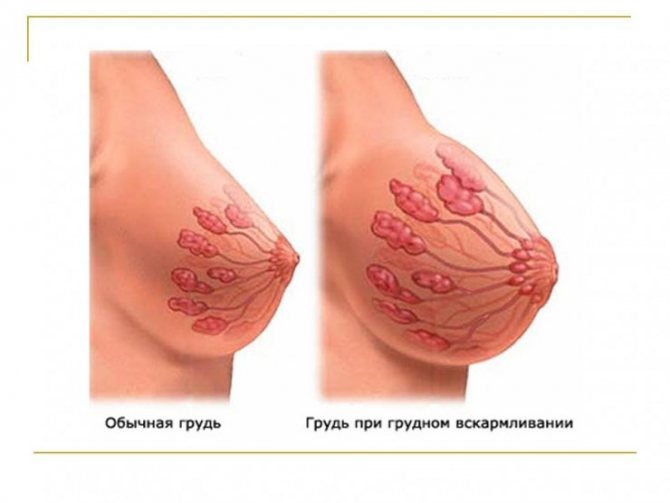
What to do if your chest becomes stone-like
Most women experience a similar condition after childbirth or a little earlier, when colostrum is replaced by milk. In addition to the natural increase in volume, increased sensitivity, and a feeling of heaviness of the breasts, a woman reveals petrification of the mammary gland. In obstetrics, this symptom is known as breast engorgement, accompanied by nipple hardening, inelasticity and pain in the areola. Sometimes the unpleasant sensation even interferes with feeding the baby. There is a decrease in nipple prominence.
These phenomena contribute to the deterioration of milk production due to increased swelling. An additional inconvenience is that pumping is difficult. To alleviate the condition, it is necessary to improve the capacity of the ducts and reduce swelling. Simple but effective methods include:
- Frequent latching of the baby to the breast.
- Physiotherapy by Jean Cotterman (pressure softening technique).
- Adequate drinking regimen (to avoid dehydration).
- Cold therapy - applying ice cubes wrapped in a towel.
- Use cabbage leaves between feedings (until they wilt completely), previously washed with soap.
Massage techniques have become especially popular; when used correctly, swelling of the mammary gland is eliminated in almost a few days. Their implementation is paramount before the pumping procedure, which can be extremely painful and impractical for this breast condition.
"Solid" milk
The balls and lumps in the breast do not always hurt; when feeding, you can feel a completely painless lump without inflammation, redness and without fever. This is a completely normal phenomenon and can occur every 2-3 months. In the first year, the baby grows spasmodically, very quickly, he needs more and more milk, and the glands do not always have time to adapt. Don’t let your breasts become engorged, it’s better to give it to your child more often, and the dense balls will disappear without a trace.
A big test for the mammary glands is the arrival of milk after stopping feeding. Imagine, you urgently need to stop feeding because you are sick with dangerous swine flu and the doctor prescribed you a “horse” dose of antibiotics. But the breast does not know about this and continues to produce milk that no one needs anymore. How to be? After all, engorgement is inevitable.
I warn you, you will have to suffer a little: pumping, taking painkillers, and maybe pills for emergency cessation of lactation (for example, Dostinex). Please note that this drug cannot dissolve milk “lumps”; you will have to carefully massage and express first one and then the other breast.
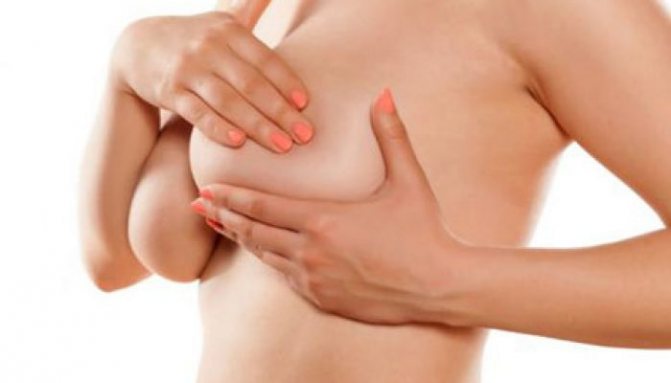
Seal prevention
To avoid lumps inside the mammary glands:
- correct attachment of the baby during breastfeeding;
- wearing a comfortable bra;
- full expression of both glands (even if the child is not hungry);
- protection from damage and injury (at home, at work);
- rejection of bad habits;
- prevention of hormonal disorders - proper alternation of work and rest;
- Maximum compliance with personal protective equipment when working in conditions of evaporation of chemicals.
Regular visits to the gynecologist allow you to identify pathology at an early stage of its development.
If you notice breast hardening and pain, it is recommended to immediately contact the clinic. Similar symptoms manifest not only mastopathy, but also postpartum mastitis, hypogalactia, cracked nipples. Through the joint efforts of specialists (gynecologist, mammologist, oncologist surgeon), it is possible to defeat any type of pathology, resorting to the latest diagnostic techniques.

